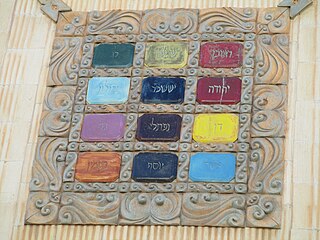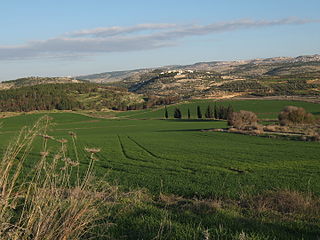The Old Testament (OT) is the first division of the Christian biblical canon, which is based primarily upon the 24 books of the Hebrew Bible, or Tanakh, a collection of ancient religious Hebrew and occasionally Aramaic writings by the Children of Israel. The second division of Christian Bibles is the New Testament, written in Koine Greek.

The Septuagint, sometimes referred to as the Greek Old Testament or The Translation of the Seventy, and often abbreviated as LXX, is the earliest extant Greek translation of the Hebrew Bible from the original Hebrew. The full Greek title derives from the story recorded in the Letter of Aristeas to Philocrates that "the laws of the Jews" were translated into the Greek language at the request of Ptolemy II Philadelphus by seventy-two Hebrew translators—six from each of the Twelve Tribes of Israel.

The Generations of Noah, also called the Table of Nations or Origines Gentium, is a genealogy of the sons of Noah, according to the Hebrew Bible, and their dispersion into many lands after the Flood, focusing on the major known societies. The term nations to describe the descendants is a standard English translation of the Hebrew word "goyim", following the c. 400 CE Latin Vulgate's "nationes", and does not have the same political connotations that the word entails today.

Sheol in the Hebrew Bible is the underworld place of stillness and darkness which lies after death.

Eber is an ancestor of the Ishmaelites and the Israelites according to the "Table of Nations" in the Book of Genesis and the Books of Chronicles.
The Letter of Aristeas to Philocrates is a Hellenistic work of the 3rd or early 2nd century BC, considered by some Biblical scholars to be pseudepigraphical. The letter is the earliest text to mention the Library of Alexandria.
Ludim is the Hebrew term for a people mentioned in Jeremiah and Ezekiel. In the Biblical Table of Nations Genesis 10:13 they were descended from Mizraim. The biblical scholar Victor P. Hamilton believes that the available evidence "suggests" that the Ludim are the Lydians.

The Nephilim are mysterious beings or people in the Hebrew Bible who are described as being large and strong. The Hebrew word Nephilim is sometimes translated as "giants", and sometimes taken to mean "the fallen ones". Their origins are disputed. Some, including the author of the Book of Enoch, view them as offspring of fallen angels and humans. Others view them as offspring of the descendants of Seth and Cain.

The priestly breastplate or breastpiece of judgment was a sacred breastplate worn by the High Priest of the Israelites, according to the Book of Exodus. In the biblical account, the breastplate is termed the breastplate of judgment, because the Urim and Thummim were placed upon it. These elements of the breastplate are said in the Exodus verse to carry the judgement of God concerning the Israelites at all times.
Zoan was, according to the Hebrew Bible, a city of Egypt in the eastern Nile delta. Book of Numbers 13:22 says that it was built seven years after Hebron was built. Psalm 78:12,43 identifies the "field of Zoan" as the location where Moses performed miracles before a biblical Pharaoh to persuade him to release the Israelites from his service. The city is also mentioned in Book of Isaiah 19:11, 13, Isaiah 30:4 and Book of Ezekiel 30:14.

The Land of Israel is the traditional Jewish name for an area of the Southern Levant. Related biblical, religious and historical English terms include the Land of Canaan, the Promised Land, the Holy Land, and Palestine. The definitions of the limits of this territory vary between passages in the Hebrew Bible, with specific mentions in Genesis 15, Exodus 23, Numbers 34 and Ezekiel 47. Nine times elsewhere in the Bible, the settled land is referred as "from Dan to Beersheba", and three times it is referred as "from the entrance of Hamath unto the brook of Egypt".
Jewish Koine Greek, or Jewish Hellenistic Greek, is the variety of Koine Greek or "common Attic" found in a number of Alexandrian dialect texts of Hellenistic Judaism, most notably in the Septuagint translation of the Hebrew Bible and associated literature, as well as in Greek Jewish texts from Palestine. The term is largely equivalent with Greek of the Septuagint as a cultural and literary rather than a linguistic category. The minor syntax and vocabulary variations in the Koine Greek of Jewish authors are not as linguistically distinctive as the later language Yevanic, or Judeo-Greek, spoken by the Romaniote Jews in Greece.

Jeremiah 47 is the forty-seventh chapter of the Book of Jeremiah in the Hebrew Bible or the Old Testament of the Christian Bible. This book contains prophecies attributed to the prophet Jeremiah, and is one of the Books of the Prophets. This chapter is part of a series of "oracles against foreign nations", consisting of chapters 46 to 51. In particular, chapters 46-49 focus on Judah's neighbors. This chapter contains the poetic oracles against the Philistines.

Jeremiah 26 is the twenty-sixth chapter of the Book of Jeremiah in the Hebrew Bible or the Old Testament of the Christian Bible. It is numbered as Jeremiah 33 in the Septuagint. This book contains prophecies attributed to the prophet Jeremiah, and is one of the Books of the Prophets. This chapter contains an exhortation to repentance, causing Jeremiah to be apprehended and arraigned ; he gives his apology, resulting the princes to clear him by the example of Micah and of Urijah, and by the care of Ahikam.

Jeremiah 37 is the thirty-seventh chapter of the Book of Jeremiah in the Hebrew Bible or the Old Testament of the Christian Bible. It is numbered as Jeremiah 44 in the Septuagint. This book contains prophecies attributed to the prophet Jeremiah, and is one of the Books of the Prophets. This chapter is the start of a narrative section consisting of chapters 37 to 44. Chapter 37 records King Zedekiah's request for prayer, Jeremiah's reply to the king, and Jeremiah's arrest and imprisonment.

Since early modern times, a number of biblical ethnonyms from the Table of Nations in Genesis 10 have been used as a basis for classifying human racial and national identities. The connection between Genesis 10 and contemporary ethnic groups began during classical antiquity, when authors such as Josephus, Hippolytus and Jerome analyzed the biblical list.








